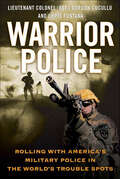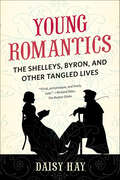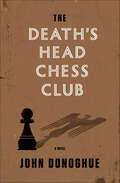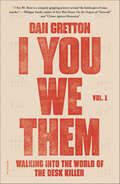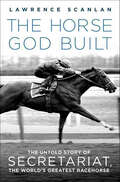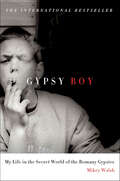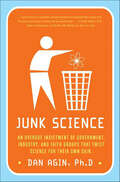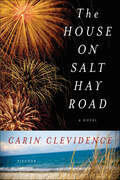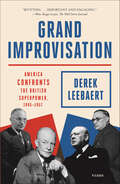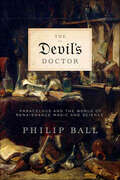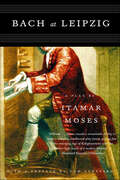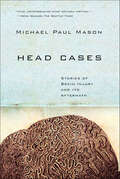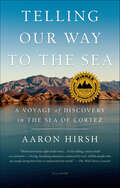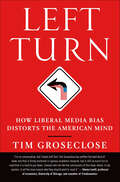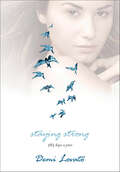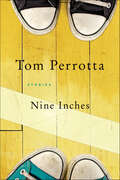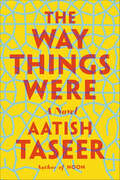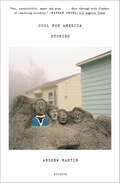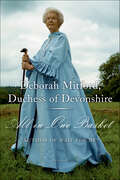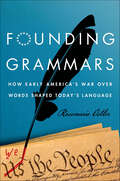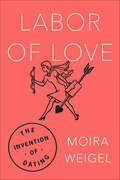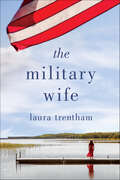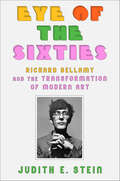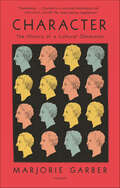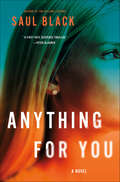- Table View
- List View
Warrior Police: Rolling with America's Military Police in the World's Trouble Spots
by Gordon Cucullu Chris FontanaFor the first time ever, author Gordon Cucullu gives readers an explosive inside look at modern military police units and their role in defending our freedom.America has been at war on several fronts since the 9/11 attack. While public attention has focused on Marines, conventional Army units, and Special Operations Forces, a lion's share of the war-fighting has been done, under media radar, by Military Police units. These squad and platoon-sized units patrol dangerous urban streets, build up local police units to improve neighborhood stability, and conduct civic action missions. On many occasions they have rushed into a vicious firefight to come to the assistance of infantry units in desperate straits. They keep villages Taliban-free, monitor balloting sites, and interdict drug shipments. In detention centers at Camp Bucha, Iraq, Bagram, Afghanistan, and Guantanamo, Cuba they guard some of the most dangerous terrorists in history.The story is told by the soldiers themselves, recounting what they have seen and experienced, along with historical context and first-hand field observations by the author team who were provided with unique inside access. Warrior Police takes readers into the bloody streets of Iraq, the dangerous back-country of Afghanistan, and wherever our Military Police are needed.
Young Romantics: The Shelleys, Byron, and Other Tangled Lives
by Daisy HayYoung Romantics tells the story of the interlinked lives of the young English Romantic poets from an entirely fresh perspective—celebrating their extreme youth and outsize yearning for friendship as well as their individuality and political radicalism. The book focuses on the network of writers and readers who gathered around Percy Bysshe Shelley and the campaigning journalist Leigh Hunt. They included Lord Byron, John Keats, and Mary Shelley, as well as a host of fascinating lesser-known figures: Mary Shelley's stepsister and Byron's mistress, Claire Clairmont; Hunt's botanist sister-in-law, Elizabeth Kent; the musician Vincent Novello; the painters Benjamin Haydon and Joseph Severn; and writers such as Charles and Mary Lamb, Thomas Love Peacock, and William Hazlitt. They were characterized by talent, idealism, and youthful ardor, and these qualities shaped and informed their politically oppositional stances—as did their chaotic family arrangements, which often left the young women, despite their talents, facing the consequences of the men's philosophies.In Young Romantics, Daisy Hay follows the group's exploits, from its inception in Hunt's prison cell in 1813 to its disintegration after Shelley's premature death in 1822. It is an enthralling tale of love, betrayal, sacrifice, and friendship, all of which were played out against a background of political turbulence and intense literary creativity.
The Death's Head Chess Club: A Novel
by John DonoghueA novel of the improbable friendship that arises between a Nazi officer and a Jewish chessplayer in AuschwitzSS Obersturmfuhrer Paul Meissner arrives in Auschwitz from the Russian front wounded and fit only for administrative duty. His most pressing task is to improve camp morale and he establishes a chess club, and allows officers and enlisted men to gamble on the games. Soon Meissner learns that chess is also played among the prisoners, and there are rumors of an unbeatable Jew known as "the Watchmaker." Meissner's superiors begin to demand that he demonstrate German superiority by pitting this undefeated Jew against the best Nazi players. Meissner finds Emil Clément, the Watchmaker, and a curious relationship arises between them. As more and more games are played, the stakes rise, and the two men find their fates deeply entwined. Twenty years later, the two meet again in Amsterdam—Meissner has become a bishop, and Emil is playing in an international chess tournament. Having lost his family in the horrors of the death camps, Emil wants nothing to do with the ex-Nazi officer despite their history, but Meissner is persistent. "What I hope," he tells Emil, "is that I can help you to understand that the power of forgiveness will bring healing." As both men search for a modicum of peace, they recall a gripping tale of survival and trust. A suspenseful meditation on understanding and guilt, John Donoghue's The Death's Head Chess Club is a bold debut and a rich portrait of a surprising friendship.
I You We Them, Vol. 1: Walking into the World of the Desk Killer (I You We Them)
by Dan GrettonA Washington Post notable nonfiction book of 2020"I You We Them is a uniquely gripping journey around the landscapes of mass murder." --Philippe Sands, author of East West Street: On the Origins of Genocide and Crimes against HumanityA Spectator (UK) Best Book of 2019A landmark historical investigation into crimes against humanity and the nature of evilVast and revelatory, Dan Gretton’s I You We Them is an unprecedented study of the perpetrators of crimes against humanity: the “desk killers” who ordered and directed some of the worst atrocities of the modern era. From Albert Speer’s complicity in Nazi barbarism to Royal Dutch Shell’s role in the murders of the Nigerian activist Ken Saro-Wiwa and the rest of the Ogoni Nine, Gretton probes the depths of the figure “who, by giving orders, uses paper or a phone or a computer to kill, instead of a gun.”Over the past twenty years, Gretton has interviewed survivors and perpetrators, and pored over archives and thousands of pages of testimony. His insight into the psychology of the desk killer is contextualized by the journey he took to penetrate it. Woven into the narrative are his contemplative interludes—perspectives gleaned during walks in the woods, reminiscences about a lost love, and considerations of timeless moral conundrums. The result is a genre-bending work steeped as much in personal reflection as it is in literature and historical and psychological illumination.A synthesis of history, reportage, and memoir, I You We Them is the first volume of a groundbreaking journal of discovery that bears witness to and reckons with the largest and most pressing questions before humanity.
The Horse God Built: The Untold Story of Secretariat, the World's Greatest Racehorse
by Lawrence ScanlanThe Horse God Built tells the amazing and heartwarming story of a Secretariat and the man who knew him best.Most of us know the legend of Secretariat, the tall, handsome chestnut racehorse whose string of honors runs long and rich: the only two-year-old ever to win Horse of the Year, in 1972; winner in 1973 of the Triple Crown, his times in all three races still unsurpassed; featured on the cover of Time, Newsweek, and Sports Illustrated; the only horse listed on ESPN's top fifty athletes of the twentieth century (ahead of Mickey Mantle). His final race at Toronto's Woodbine Racetrack is a touchstone memory for horse lovers everywhere. Yet while Secretariat will be remembered forever, one man, Eddie "Shorty" Sweat, who was pivotal to the great horse's success, has been all but forgotten--until now. In The Horse God Built, bestselling equestrian writer Lawrence Scanlan has written a tribute to an exceptional man that is also a backroads journey to a corner of the racing world rarely visited. As a young black man growing up in South Carolina, Eddie Sweat struggled at several occupations before settling on the job he was born for--groom to North America's finest racehorses. As Secretariat's groom, loyal friend, and protector, Eddie understood the horse far better than anyone else. A wildly generous man who could read a horse with his eyes, he shared in little of the financial success or glamour of Secretariat's wins on the track, but won the heart of Big Red with his soft words and relentless devotion.In Scanlan's rich narrative, we get a groom's-eye view of the racing world and the vantage of a man who spent every possible moment with the horse he loved, yet who often basked in the horse's glory from the sidelines. More than anything else, The Horse God Built is a moving portrait of the powerful bond between human and horse.
Gypsy Boy: My Life in the Secret World of the Romany Gypsies
by Mikey WalshAn Eye-Opening Memoir of Growing Up GypsyMikey Walsh was born into a Romany Gypsy family. They live in a secluded community, and little is known about their way of life. After centuries of persecution, Gypsies are wary of outsiders, and if you choose to leave you can never come back.This is something Mikey knows only too well.Growing up, he didn't go to school, he seldom mixed with non-Gypsies, and the caravan became his world. It was a rich and unusual upbringing, but although Mikey inherited a vibrant and loyal culture his family's legacy was bittersweet, with a hidden history of violence and grief. Eventually Mikey was forced to make an agonizing decision—to stay and keep secrets, or escape and find somewhere to belong.Gypsy Boy shows, for the first time, what life is really like among the Romany Gypsies. A surprise #1 bestseller in Great Britain, this is a one-of-a-kind memoir of a little-seen world, one both fascinating and heartbreaking.
Junk Science: An Overdue Indictment of Government, Industry, and Faith Groups that Twist Science for Their Own Gain
by Dan AginAn overdue indictment of government, industry, and faith groups that twist science for their own gain.During the next thirty years, the American public will suffer from a rampage against reason by special interests in government, commerce, and the faith industry, and the rampage has already begun. In Junk Science, Dan Agin offers a response—a stinging condemnation of the egregious and constant warping of science for ideological gain.In this provocative, wide-ranging, and hard-hitting book, Agin argues from the center that we will pay a heavy price for the follies of people who consciously twist the public's understanding of the real world.In an entertaining but frank tone, Agin separates fact from conveniently "scientific" fiction and exposes the data faking, reality ignoring, fear mongering, and outright lying that contribute to intentionally manufactured public ignorance. Many factions twist scientific data to maintain riches and power, and Agin outs them all in sections like these:--"Buyer Beware" (genetically modified foods, aging, and tobacco companies)--"Medical Follies" (chiropractics, health care, talk therapy)--"Poison and Bombs in the Greenhouse" (pollution, warfare, global warming)--"Religion, Embryos, and Cloning"--"Genes, Behavior, and Race"We already pay a heavy price for many groups' conscious manipulation of the public's understanding of science, and Junk Science arms us with understanding, cutting through the fabric of lies and setting the record straight.
The House on Salt Hay Road: A Novel
by Carin ClevidenceA fireworks factory explodes in a quiet seaside town. In the house on Salt Hay Road, Clay Poole is thrilled by the hole it's blown in everyday life. His older sister, Nancy, is more interested in the striking stranger who appears, dusted with ashes, in the explosion's aftermath. The Pooles—taken in as orphans by their mother's family—can't yet know how the bonds of their makeshift household will be tested and frayed. As their aunt searches for signs from God and their uncle begins an offbeat courtship, they are pulled toward two greater cataclysms: the legendary hurricane of 1938 and the encroaching war.The House on Salt Hay Road is suffused with a haunting sense of place: salt marshes in the summer, ice boats on the frozen Great South Bay, Fire Island at the height of a storm. A vivid and emotionally resonant debut, it captures the golden light of a vanished time, and the hold that home has on us long after we leave it.
Grand Improvisation: America Confronts the British Superpower, 1945–1957
by Derek LeebaertA new understanding of the post World War II era, showing what occurred when the British Empire wouldn’t step aside for the rising American superpower—with global insights for today.An enduring myth of the twentieth century is that the United States rapidly became a superpower in the years after World War II, when the British Empire—the greatest in history—was too wounded to maintain a global presence. In fact, Derek Leebaert argues in Grand Improvisation, the idea that a traditionally insular United States suddenly transformed itself into the leader of the free world is illusory, as is the notion that the British colossus was compelled to retreat. The United States and the U.K. had a dozen abrasive years until Washington issued a “declaration of independence” from British influence. Only then did America explicitly assume leadership of the world order just taking shape. Leebaert’s character-driven narrative shows such figures as Churchill, Truman, Eisenhower, and Kennan in an entirely new light, while unveiling players of at least equal weight on pivotal events. Little unfolded as historians believe: the Truman Doctrine and the Marshall Plan; the Korean War; America’s descent into Vietnam. Instead, we see nonstop U.S. improvisation until America finally lost all caution and embraced obligations worldwide, a burden we bear today.Understanding all of this properly is vital to understanding the rise and fall of superpowers, why we’re now skeptical of commitments overseas, how the Middle East plunged into disorder, why Europe is fracturing, what China intends—and the ongoing perils to the U.S. world role.
The Devil's Doctor: Paracelsus and the World of Renaissance Magic and Science
by Philip BallPhilippus Aureolus Theophrastus Bombast von Hohenheim, who called himself Paracelsus, stands at the cusp of medieval and modern times. A contemporary of Luther, an enemy of the medical establishment, a scourge of the universities, an alchemist, an army surgeon, and a radical theologian, he attracted myths even before he died. His fantastic journeys across Europe and beyond were said to be made on a magical white horse, and he was rumored to carry the elixir of life in the pommel of his great broadsword. His name was linked with Faust, who bargained with the devil.Who was the man behind these stories? Some have accused him of being a charlatan, a windbag who filled his books with wild speculations and invented words. Others claim him as the father of modern medicine. Philip Ball exposes a more complex truth in The Devil's Doctor—one that emerges only by entering into Paracelsus's time. He explores the intellectual, political, and religious undercurrents of the sixteenth century and looks at how doctors really practiced, at how people traveled, and at how wars were fought. For Paracelsus was a product of an age of change and strife, of renaissance and reformation. And yet by uniting the diverse disciplines of medicine, biology, and alchemy, he assisted, almost in spite of himself, in the birth of science and the emergence of the age of rationalism. "Ball produces a vibrant, original portrait of a man of contradictions:" - Publishers Weekly
Bach at Leipzig: A Play
by Itamar MosesLeipzig, Germany, 1722: Johann Kuhnau, revered organist of the Thomaskirche, suddenly dies, leaving his post vacant. In order to fill the position, the city council invites a small number of musicians to audition for the appointment, including Johann Sebastian Bach. This, however, is not his story. Based on actual events, Bach at Leipzig imagines with uncommon intelligence and wit how six little-known musicians resorted to bribery, blackmail, and betrayal in an attempt to secure the most coveted musical post in all of Europe.
Head Cases: Stories of Brain Injury and Its Aftermath
by Michael Paul MasonHead Cases takes us into the dark side of the brain in an astonishing sequence of stories, at once true and strange, from the world of brain damage. Michael Paul Mason is one of an elite group of experts who coordinate care in the complicated aftermath of tragic injuries that can last a lifetime. On the road with Mason, we encounter survivors of brain injuries as they struggle to map and make sense of the new worlds they inhabit.Underlying each of these survivors' stories is an exploration of the brain and its mysteries. When injured, the brain must figure out how to heal itself, reorganizing its physiology in order to do the job. Mason gives us a series of vivid glimpses into brain science, the last frontier of medicine, and we come away in awe of the miracles of the brain's workings and astonished at the fragility of the brain and the sense of self, life, and order that resides there. Head Cases "[achieves] through sympathy and curiosity insight like that which pulses through genuine literature" (The New York Sun); it is at once illuminating and deeply affecting.
Telling Our Way to the Sea: A Voyage of Discovery in the Sea of Cortez
by Aaron HirshA luminous and revelatory journey into the science of life and the depths of the human experienceBy turns epic and intimate, Telling Our Way to the Sea is both a staggering revelation of unraveling ecosystems and a profound meditation on our changing relationships with nature—and with one another.When the biologists Aaron Hirsh and Veronica Volny, along with their friend Graham Burnett, a historian of science, lead twelve college students to a remote fishing village on the Sea of Cortez, they come upon a bay of dazzling beauty and richness. But as the group pursues various threads of investigation—ecological and evolutionary studies of the sea, the desert, and their various species of animals and plants; the stories of local villagers; the journals of conquistadors and explorers—they recognize that the bay, spectacular and pristine though it seems, is but a ghost of what it once was. Life in the Sea of Cortez, they realize, has been reshaped by complex human ideas and decisions—the laws and economics of fishing, property, and water; the dreams of developers and the fantasies of tourists seeking the wild; even efforts to retrieve species from the brink of extinction—all of which have caused dramatic upheavals in the ecosystem. It is a painful realization, but the students discover a way forward. After weathering a hurricane and encountering a rare whale in its wake, they come to see that the bay's best chance of recovery may in fact reside in our own human stories, which can weave a compelling memory of the place. Glimpsing the intricate and ever-shifting web of human connections with the Sea of Cortez, the students comprehend anew their own place in the natural world—suspended between past and future, teetering between abundance and loss. The redemption in their difficult realization is that as they find their places in a profoundly altered environment, they also recognize their roles in the path ahead, and ultimately come to see one another, and themselves, in a new light.In Telling Our Way to the Sea, Hirsh's voice resounds with compassionate humanity, capturing the complex beauty of both the marine world he explores and the people he explores it with. Vibrantly alive with sensitivity and nuance, Telling Our Way to the Sea transcends its genre to become literature.
Left Turn: How Liberal Media Bias Distorts the American Mind
by Tim GrosecloseA leading political science professor provides scientific proof of media bias in this sure-to-be-controversial bookDr. Tim Groseclose, a professor of political science and economics at UCLA, has spent years constructing precise, quantitative measures of the slant of media outlets. He does this by measuring the political content of news, as a way to measure the PQ, or "political quotient" of voters and politicians. Among his conclusions are: (i) all mainstream media outlets have a liberal bias; and (ii) while some supposedly conservative outlets—such the Washington Times or Fox News' Special Report—do lean right, their conservative bias is less than the liberal bias of most mainstream outlets. Groseclose contends that the general leftward bias of the media has shifted the PQ of the average American by about 20 points, on a scale of 100, the difference between the current political views of the average American, and the political views of the average resident of Orange County, California or Salt Lake County, Utah. With Left Turn readers can easily calculate their own PQ—to decide for themselves if the bias exists. This timely, much-needed study brings fact to this often overheated debate.
Staying Strong: 365 Days a Year
by Demi LovatoDemi Lovato wakes up each morning and affirms her commitment to herself—to her health, her happiness, her being. Those commitments are the bedrock of her recovery and her work helping other young people dealing with the issues she lives with every single day. Demi is a platinum-selling recording artist whose latest album—DEMI—is already a smash hit. She's about to embark on her second season as a judge on X-Factor, and just launched The Lovato Treatment Scholarship Program. And she is an outspoken advocate for young people everywhere. Demi is also a young woman finding her way in the world. She has dealt deftly with her struggles in the face of public scrutiny, and she has always relied, not just on friends and family, but daily affirmations of her self-worth and value. Affirmations that steady her days and strengthen her resolve. Those affirmations have grown into STAYING STRONG, a powerful 365-day collection of Demi's most powerful, honest, and hopeful insights. Each day will provide the readers with a quote, a personal reflection and a goal. These are Demi's words. Words she lives by and shares with the people she loves and total strangers alike. They are a powerful testament to a young woman standing up and fighting back.
Nine Inches: Stories
by Tom PerrottaA stunning short story collection from the New York Times bestselling author of The Leftovers and Little Children, featuring stories focusing on Tom Perrotta's familiar suburban nuclear familiesNine Inches, Perrotta's first true collection, features ten stories—some sharp and funny, some mordant and surprising, and a few intense and disturbing. Whether he's dropping into the lives of two teachers—and their love lost and found—in "Nine Inches", documenting the unraveling of a dad at a Little League game in "The Smile on Happy Chang's Face", or gently marking the points of connection between an old woman and a benched high school football player in "Senior Season", Perrotta writes with a sure sense of his characters and their secret longings.Nine Inches contains an elegant collection of short fiction: stories that are as assured in their depictions of characters young and old, established and unsure, as any written today.
The Way Things Were: A Novel
by Aatish TaseerAn absorbing family saga set amid the commotion of the last forty years of Indian historyThe Way Things Were opens with the death of Toby, the Maharaja of Kalasuryaketu, a Sanskritist who has not set foot in India for two decades. Moving back and forth across three sections, between today's Delhi and the 1970s, '80s, and '90s in turn, the novel tells the story of a family held at the mercy of the times. A masterful interrogation of the relationships between past and present and among individual lives, events, and culture, Aatish Taseer's The Way Things Were takes its title from the Sanskrit word for history, itihasa, whose literal translation is "the way things indeed were." Told in prose that is at once intimate and panoramic, and threaded through with Sanskrit as central metaphor and chorus, this is a hugely ambitious and important book, alive to all the commotion of the last forty years but never losing its brilliant grasp on the current moment.
Cool for America: Stories
by Andrew MartinExpanding the world of his classic-in-the-making debut novel Early Work, Andrew Martin’s Cool for America is a hilarious collection of overlapping stories that explores the dark zone between artistic ambition and its achievementThe collection is bookended by the misadventures of Leslie, a young woman (first introduced in Early Work) who moves from New York to Missoula, Montana to try to draw herself out of a lingering depression, and, over the course of the book, gains painful insight into herself through a series of intense friendships and relationships.Other stories follow young men and women, alone and in couples, pushing hard against, and often crashing into, the limits of their abilities as writers and partners. In one story, two New Jersey siblings with substance-abuse problems relapse together on Christmas Eve; in another, a young couple tries to make sense of an increasingly unhinged veterinarian who seems to be tapping, deliberately or otherwise, into the unspoken troubles between them. In tales about characters as they age from punk shows and benders to book clubs and art museums, the promise of community acts—at least temporarily—as a stay against despair.Running throughout Cool for America is the characters’ yearning for transcendence through art: the hope that, maybe, the perfect, or even just the good-enough sentence, can finally make things right.
All in One Basket: A Memoir
by Deborah MitfordIn her beguiling memoir, Wait for Me!, Deborah Mitford, Duchess of Devonshire (and the youngest of the famously witty brood of writers, agitators, and icons), recounted her eventful life with wit and grace. All in One Basket collects the Duchess of Devonshire's breezy, occasional writings and provides a disarming look at a life lived with great zest and originality.All in One Basket combines two earlier collections, Counting My Chickens and Home to Roost, its sequel, which was never published in the United States. In these pages, we hear anecdotes about famous friends from Evelyn Waugh to John F. Kennedy; tales of struggle and success at Chatsworth, England's greatest stately home; and of course the tales of her beloved chickens, which the Duchess began raising as a child for pocket money. In All in One Basket, glamorous recollections happily coexist with practical insights into country life, and the result is a revelatory, intimate portrait of a woman described by The New York Times as a "national treasure."
Founding Grammars: How Early America's War Over Words Shaped Today's Language
by Rosemarie OstlerWho decided not to split infinitives? With whom should we take issue if in fact, we wish to boldly write what no grammarian hath writ before? In Founding Grammars, Rosemarie Ostler delves into the roots of our grammar obsession to answer these questions and many more. Standard grammar and accurate spelling are widely considered hallmarks of a good education, but their exact definitions are much more contentious - capable of inciting a full-blown grammar war at the splice of a comma, battles readily visible in the media and online in the comments of blogs and chat rooms. With an accessible and enthusiastic journalistic approach, Ostler considers these grammatical shibboleths, tracing current debates back to America's earliest days, an era when most families owned only two books - the Bible and a grammar primer. Along the way, she investigates colorful historical characters on both sides of the grammar debate in her efforts to unmask the origins of contemporary speech. Linguistic founding fathers like Noah Webster, Tory expatriate Lindley Murray, and post-Civil War literary critic Richard Grant White,all play a featured role in creating the rules we've come to use, and occasionally discard, throughout the years. Founding Grammars is for curious readers who want to know where grammar rules have come from, where they've been, and where they might go next.
Labor of Love: The Invention of Dating
by Moira Weigel“Does anyone date anymore?” Today, the authorities tell us that courtship is in crisis. But when Moira Weigel dives into the history of sex and romance in modern America, she discovers that authorities have always said this. Ever since young men and women started to go out together, older generations have scolded them: That’s not the way to find true love. The first women who made dates with strangers were often arrested for prostitution; long before “hookup culture,” there were “petting parties”; before parents worried about cell phone apps, they fretted about joyrides and “parking.” Dating is always dying. But this does not mean that love is dead. It simply changes with the economy. Dating is, and always has been, tied to work. Lines like “I’ll pick you up at six” made sense at a time when people had jobs that started and ended at fixed hours. But in an age of contract work and flextime, many of us have become sexual freelancers, more likely to text a partner “u still up?” Weaving together over one hundred years of history with scenes from the contemporary landscape, Labor of Love offers a fresh feminist perspective on how we came to date the ways we do. This isn't a guide to “getting the guy.” There are no ridiculous “rules” to follow. Instead, Weigel helps us understand how looking for love shapes who we are—and hopefully leads us closer to the happy ending that dating promises.
The Military Wife: A Heart Of A Hero Novel (Heart Of A Hero Ser. #1)
by Laura TrenthamA young widow embraces a second chance at life when she reconnects with those who understand the sacrifices made by American soldiers and their families in award-winning author Laura Trentham’s The Military Wife.Harper Lee Wilcox has been marking time in her hometown of Kitty Hawk, North Carolina since her husband, Noah Wilcox’s death, nearly five years earlier. With her son Ben turning five and living at home with her mother, Harper fights a growing restlessness, worried that moving on means leaving the memory of her husband behind.Her best friend, Allison Teague, is dealing with struggles of her own. Her husband, a former SEAL that served with Noah, was injured while deployed and has come home physically healed but fighting PTSD. With three children underfoot and unable to help her husband, Allison is at her wit’s end.In an effort to reenergize her own life, Harper sees an opportunity to help not only Allison but a network of other military wives eager to support her idea of starting a string of coffee houses close to military bases around the country.In her pursuit of her dream, Harper crosses paths with Bennett Caldwell, Noah’s best friend and SEAL brother. A man who has a promise to keep, entangling their lives in ways neither of them can foresee. As her business grows so does an unexpected relationship with Bennett. Can Harper let go of her grief and build a future with Bennett even as the man they both loved haunts their pasts?
Eye of the Sixties: Richard Bellamy and the Transformation of Modern Art
by Judith E. SteinIn 1959, Richard Bellamy was a witty, poetry-loving beatnik on the fringe of the New York art world who was drawn to artists impatient for change. By 1965, he was representing Mark di Suvero, was the first to show Andy Warhol’s pop art, and pioneered the practice of “off-site” exhibitions and introduced the new genre of installation art. As a dealer, he helped discover and champion many of the innovative successors to the abstract expressionists, including Claes Oldenburg, James Rosenquist, Donald Judd, Dan Flavin, Walter De Maria, and many others. The founder and director of the fabled Green Gallery on Fifty-Seventh Street, Bellamy thrived on the energy of the sixties. With the covert support of America’s first celebrity art collectors, Robert and Ethel Scull, Bellamy gained his footing just as pop art, minimalism, and conceptual art were taking hold and the art world was becoming a playground for millionaires. Yet as an eccentric impresario dogged by alcohol and uninterested in profits or posterity, Bellamy rarely did more than show the work he loved. As fellow dealers such as Leo Castelli and Sidney Janis capitalized on the stars he helped find, Bellamy slowly slid into obscurity, becoming the quiet man in oversize glasses in the corner of the room, a knowing and mischievous smile on his face.Born to an American father and a Chinese mother in a Cincinnati suburb, Bellamy moved to New York in his twenties and made a life for himself between the Beat orbits of Provincetown and white-glove events like the Guggenheim’s opening gala. No matter the scene, he was always considered “one of us,” partying with Norman Mailer, befriending Diane Arbus and Yoko Ono, and hosting or performing in historic Happenings. From his early days at the Hansa Gallery to his time at the Green to his later life as a private dealer, Bellamy had his finger on the pulse of the culture. Based on decades of research and on hundreds of interviews with Bellamy’s artists, friends, colleagues, and lovers, Judith E. Stein’s Eye of the Sixties rescues the legacy of the elusive art dealer and tells the story of a counterculture that became the mainstream. A tale of money, taste, loyalty, and luck, Richard Bellamy’s life is a remarkable window into the art of the twentieth century and the making of a generation’s aesthetic.--"Bellamy had an understanding of art and a very fine sense of discovery. There was nobody like him, I think. I certainly consider myself his pupil." --Leo Castelli
Character: The History of a Cultural Obsession
by Marjorie GarberWhat is “character”?Since at least Aristotle’s time, philosophers, theologians, moralists, artists, and scientists have pondered the enigma of human character. In its oldest usage, “character” derives from a word for engraving or stamping, yet over time, it has come to mean a moral idea, a type, a literary persona, and a physical or physiological manifestation observable in works of art and scientific experiments. It is an essential term in drama and the focus of self-help books. In Character: The History of a Cultural Obsession, Marjorie Garber points out that character seems more relevant than ever today, omnipresent in discussions of politics, ethics, gender, morality, and the psyche. References to character flaws, character issues, and character assassination and allegations of “bad” and “good” character are inescapable in the media and in contemporary political debates. What connection does “character” in this moral or ethical sense have with the concept of a character in a novel or a play? Do our notions about fictional characters catalyze our ideas about moral character? Can character be “formed” or taught in schools, in scouting, in the home? From Plutarch to John Stuart Mill, from Shakespeare to Darwin, from Theophrastus to Freud, from nineteenth-century phrenology to twenty-first-century brain scans, the search for the sources and components of human character still preoccupies us. Today, with the meaning and the value of this term in question, no issue is more important, and no topic more vital, surprising, and fascinating. With her distinctive verve, humor, and vast erudition, Marjorie Garber explores the stakes of these conflations, confusions, and heritages, from ancient Greece to the present day.
Anything for You: A Novel (Valerie Hart #3)
by Saul Black"The writing is sharp as the devil." —Stephen KingCritically acclaimed author Saul Black returns with a heart-racing thriller in which a brutal murder forces one woman to reckon with her own past—and her future.On a hot summer night, a watchful neighbor locks eyes with an intruder and unwittingly alerts the police to a vicious crime scene next door: a lavish master bedroom where a man lies dead. Next to him, his wife is bleeding out onto the hardwood floor, clinging to life. The victim, Adam Grant, was a well-known San Francisco prosecutor—a man whose connection to Homicide detective Valerie Hart brings her face-to-face with a life she’s long since left behind. Adam’s career made him an easy target, and forensic evidence points towards an ex-con he put behind bars years ago. But while Adam’s wife and daughter grapple with their tragic loss, Valerie uncovers devastating clues that point in a more ominous direction. Lurking in the shadows of the Grants’ pristine life is a mysterious blonde who holds the key to a very different—and much darker—story. As Valerie struggles to forge a new path for herself, the investigation forces her to confront the question: can we ever really leave our pasts behind? Sophisticated and stunning, Anything for You is an unforgettable thriller that will grip readers long after turning the last page.
